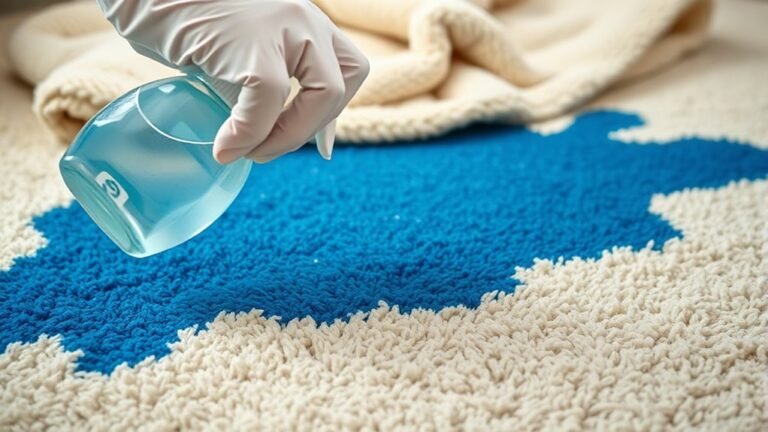Dealing With Hard-To-Reach Cobwebs in High Ceilings
Dealing with cobwebs on high ceilings means staying safe and using the right tools. You’ll want a sturdy ladder and protective gear like gloves and goggles. Extendable dusters or vacuum attachments make reaching those spots easier without risk. Regular cleaning and sealing entry points helps keep spiders away long-term. If cobwebs keep coming back despite your efforts, there are smarter ways to handle them that can save you time and effort—discover what those are next.
Understanding Why Cobwebs Accumulate on High Ceilings

Although cobwebs can appear anywhere, they tend to gather on high ceilings because these areas are less disturbed and provide a safe haven for spiders. When you understand cobweb formation, you realize spiders choose spots where they won’t be constantly disrupted. High ceilings offer quiet, undisturbed spider habitats, allowing webs to remain intact and grow over time. These elevated areas also have fewer air currents and human activity, making them perfect for spiders to hunt and build their homes. By recognizing why cobwebs accumulate there, you gain insight into spider behavior and their preference for freedom and safety. This knowledge empowers you to address cobwebs efficiently, without unnecessary fuss, while respecting the natural tendencies of these resilient creatures.
Essential Safety Precautions Before Cleaning High Areas
Before you start cleaning cobwebs from high ceilings, make sure you choose the right ladder for stability and height. Don’t forget to wear secure protective gear like gloves and goggles to keep yourself safe. Also, take a moment to check for any hazards around your workspace to avoid accidents.
Proper Ladder Selection
Choosing the right ladder is essential for safely reaching high ceilings when dealing with cobwebs. You want freedom to move without worrying about slips or falls. Here’s how to pick the best ladder for the job:
- Know ladder types: Choose between step ladders, extension ladders, or multi-position ladders depending on your ceiling height and access.
- Check ladder stability: Look for wide, slip-resistant feet and sturdy locks to keep you steady.
- Consider ladder height: Make sure it’s tall enough to reach cobwebs without overreaching or standing on the top rung.
- Evaluate ladder weight: Pick one you can easily carry and position but strong enough to support you safely.
Secure Protective Gear
Once you’ve picked the right ladder to reach those high corners safely, the next step is to protect yourself while cleaning. Don’t skip on securing protective gear—it’s essential for your freedom to move confidently without worry. Slip on protective eyewear to shield your eyes from dust, debris, and stray cobwebs that might fall unexpectedly. Safety gloves are a must, too; they guard your hands from irritants and sharp edges you might encounter up high. By gearing up properly, you’re not just following rules—you’re taking control of your cleaning mission. This way, you stay safe and comfortable, letting you focus on the task without distractions or risks holding you back. Your freedom to clean efficiently starts with smart protection.
Assess Surrounding Hazards
Hazards like loose light fixtures, unstable furniture, or tangled cords can turn your cleaning task into a risky ordeal. Before you start, it’s essential to practice hazard awareness and perform a quick risk assessment of your surroundings. Here’s what you should do:
- Scan the area for any unstable items that could shift or fall.
- Check for electrical hazards, like exposed wires or overloaded outlets.
- Clear pathways to avoid tripping over cords or clutter.
- Confirm your ladder or step stool is placed on a flat, stable surface.
Choosing the Right Tools for Reaching High Cobwebs
You’ll want to pick the right tools to safely reach those high cobwebs without stretching too far. Telescoping poles are great for extending your reach, and there are specialized cleaning attachments designed to grab webs easily. Choosing the right combination makes the job quicker and keeps you steady.
Extending Pole Options
Although reaching high cobwebs can be tricky, choosing the right extending pole makes the task much easier. Extendable reachers with adjustable lengths give you the freedom to clean without ladders or risky climbs. Here’s what to keep in mind:
- Length flexibility: Pick poles that extend smoothly to match your ceiling height.
- Lightweight design: You want easy handling without arm fatigue.
- Secure locking: Poles with reliable locks won’t collapse mid-cleaning.
- Kompatibilität: Make sure your pole fits the cleaning tool you prefer.
With these options, you can tackle those stubborn cobwebs confidently and safely, enjoying the freedom to clean every corner without limits.
Specialized Cleaning Attachments
Once you’ve chosen the right extending pole, picking the proper cleaning attachment can make reaching and removing cobwebs even easier. Specialized equipment like swivel brushes, microfiber dusters, and vacuum attachments are designed to tackle cobwebs without damaging your high ceilings. A swivel brush lets you adjust angles freely, giving you access to corners with minimal effort. Microfiber dusters trap dust and debris efficiently, reducing the need for extra cleanup. Vacuum attachments with soft bristles can suck up webs without scattering them. By combining these specialized tools with effective cleaning techniques, you gain the freedom to maintain your space without ladders or strain. Choose attachments that fit your pole securely and match your ceiling’s surface for smooth, hassle-free cobweb removal every time.
Step-by-Step Guide to Removing Cobwebs Safely

Before you start removing cobwebs from high ceilings, it’s important to gather the right tools and plan your approach carefully to guarantee safety. Effective cobweb removal techniques and consistent high ceiling maintenance keep your space fresh and free.
Follow these steps:
- Secure a sturdy ladder or step stool to reach high spots comfortably.
- Wear protective eyewear and a dust mask to guard against debris.
- Use a soft brush or microfiber cloth to gently dislodge cobwebs without damaging surfaces.
- Dispose of cobwebs promptly, preventing them from settling elsewhere.
Using Extendable Dusters and Vacuum Attachments
When you need to reach cobwebs high above without climbing, extendable dusters and vacuum attachments can be real lifesavers. These tools give you the freedom to clean safely and efficiently from the floor. Extendable dusters let you adjust the length, so you can easily touch ceiling corners and light fixtures, gently sweeping away webs without damage. Vacuum attachments with long hoses or flexible wands not only reach high spots but also suck up debris instantly, keeping your space tidy without stirring up dust. Both options save you from precarious balancing acts on ladders, letting you stay grounded and worry-free. With these handy tools, maintaining your home’s pristine look is simple, safe, and liberating—giving you more time to enjoy your space.
Alternative Methods: Using Brooms and Mops Effectively

Although extendable dusters and vacuum attachments are great, you might find that a broom or mop can also do the trick for high cobwebs. Here’s how to use broom techniques and mop strategies to your advantage:
- Choose a broom with soft bristles to avoid damaging surfaces while sweeping cobwebs away.
- For mop strategies, use a dry mop with a flat head to reach corners and ceiling edges.
- Extend your reach by attaching a pole to your broom or mop, giving you freedom without climbing.
- Move slowly and gently to prevent cobweb debris from scattering, making cleanup easier.
These tools offer you a simple, accessible way to clear cobwebs, keeping your space free and clear without extra gadgets.
Preventative Measures to Minimize Cobweb Formation
Using brooms and mops effectively can help you clear cobwebs, but preventing them from forming in the first place saves time and effort. You can maintain freedom from constant cleaning by adopting simple preventative cleaning habits and scheduling regular inspections. Staying ahead means less hassle and more control over your space.
| Preventative Cleaning Tips | Regular Inspection Focus |
|---|---|
| Dust corners weekly | Check ceiling edges |
| Seal window gaps | Look for spider activity |
| Declutter spaces | Inspect light fixtures |
| Use natural repellents | Monitor air vents |
When to Consider Professional Cleaning Services
If you find that cobwebs keep reappearing despite your best efforts, it might be time to call in professional cleaning services. Knowing when to hire experts can save you time and frustration, giving you the freedom to focus on what matters most. Here are clear signs needing help:
- Cobwebs are in hard-to-reach spots that pose safety risks.
- You notice persistent webs despite regular cleaning.
- Allergies worsen due to dust and spider debris.
- You want a thorough, lasting clean beyond surface removal.
Recognizing these signs needing help guarantees you don’t get stuck in a cycle of endless cleaning. Professionals bring the right tools and expertise, freeing you from the hassle and keeping your high ceilings pristine.
Maintaining Clean Ceilings With Regular Upkeep
While professional cleaning can tackle stubborn cobwebs, maintaining high ceilings between visits helps keep them looking fresh longer. You can enjoy the freedom of a clean, inviting space by committing to regular cleaning routines. Simple tools like extendable dusters or microfiber cloths make ceiling maintenance manageable without special equipment. Focus on quick, consistent touch-ups to prevent webs from settling and multiplying. Establish a schedule—perhaps monthly or bi-monthly—to inspect and dust those hard-to-reach spots. This proactive approach reduces the need for intensive cleanings and preserves your ceiling’s appearance effortlessly. By taking these small steps, you reclaim control over your environment, avoiding the buildup that limits your home’s comfort and charm. Regular ceiling maintenance keeps your space feeling open and welcoming without hassle.
Häufig gestellte Fragen
What Types of Spiders Create the Most Stubborn Cobwebs Indoors?
Ever felt like you’re facing a tiny fortress? When it comes to stubborn cobwebs indoors, it’s often the common house spider whose habits make webs tougher than you’d expect. Unlike the delicate weavings of other species, their web strength compares to a resilient net, crafted to trap even the most elusive prey. Understanding these house spider habits can help you reclaim your space and enjoy freedom from persistent webs.
Can Natural Repellents Help Prevent Spiders From Making Cobwebs?
You’ll find that natural deterrents can definitely help influence spider behavior and reduce cobwebs. Essential oils like peppermint, eucalyptus, or citrus work as natural repellents, making your space less inviting to spiders. Since spiders dislike these scents, using them regularly encourages them to stay away, giving you more freedom from unwanted webs. While it’s not foolproof, combining natural deterrents with regular cleaning can keep your home spider-friendly without harsh chemicals.
How Often Should High Ceilings Be Inspected for Cobwebs?
Think of your high ceilings as a hidden sky where cobwebs quietly spin their tales. You should set a cleaning frequency to inspect these lofty domains at least once a month. Using inspection methods like telescopic dusters or even a lightweight drone can help you reach those unseen corners without chains holding you down. This way, you maintain freedom from unwanted webs while keeping your space fresh and inviting.
Are There Any Health Risks Associated With Disturbing Old Cobwebs?
You might worry about health risks when disturbing old cobwebs, and that’s smart. Those webs can hold dust and allergens, so if you have cobweb allergies, stirring them up could trigger sneezing or irritation. Plus, dust exposure can affect your lungs, especially if you’re sensitive or have asthma. To keep your freedom to breathe easy, wear a mask and gently remove webs to minimize risks and stay comfortable.
What Lighting Conditions Make Cobwebs More Visible for Cleaning?
To spot cobwebs more easily, you’ll want to focus on lighting techniques that boost visibility factors. Using a bright, angled light source—like a flashlight or a portable lamp—creates shadows that highlight webs against walls or ceilings. Natural light from windows during the day also helps. By adjusting your lighting angle, you’re freeing yourself to see every hidden strand, making cleaning quicker and more effective without missing any pesky webs.






